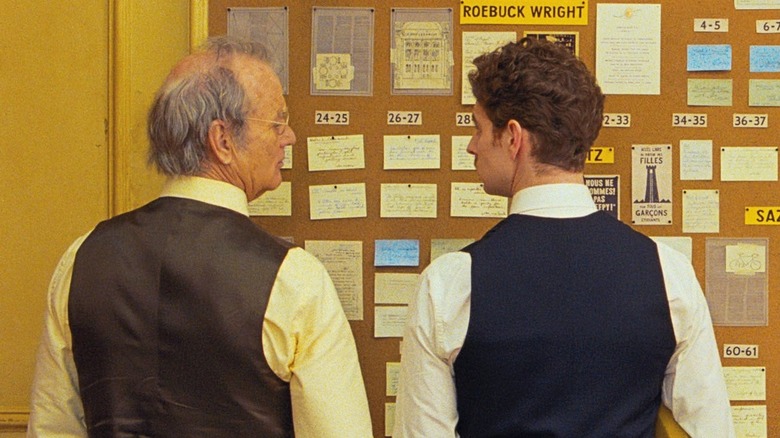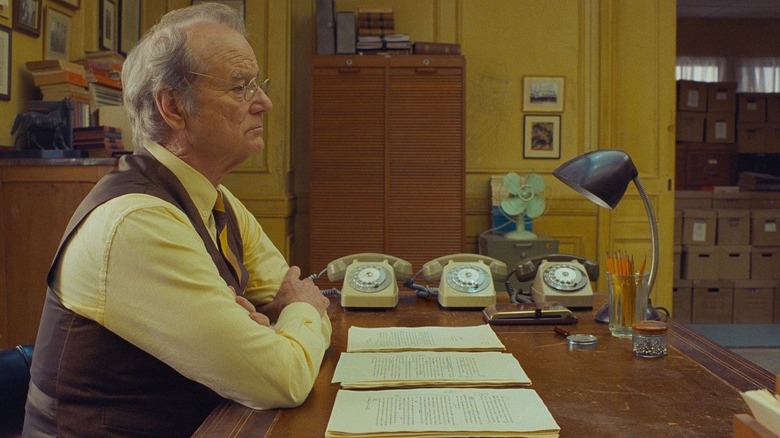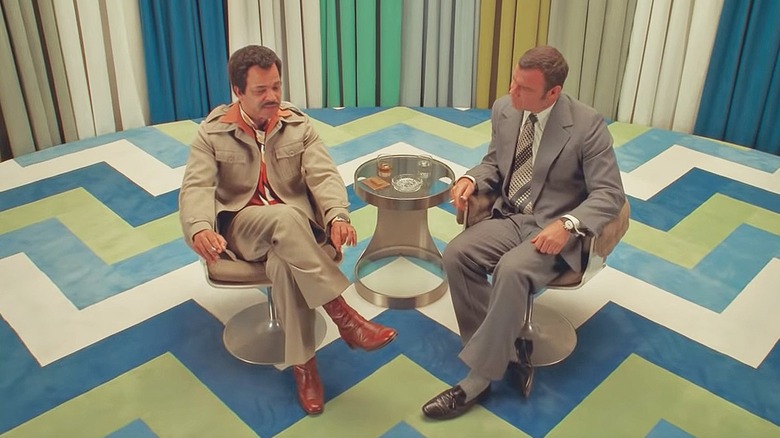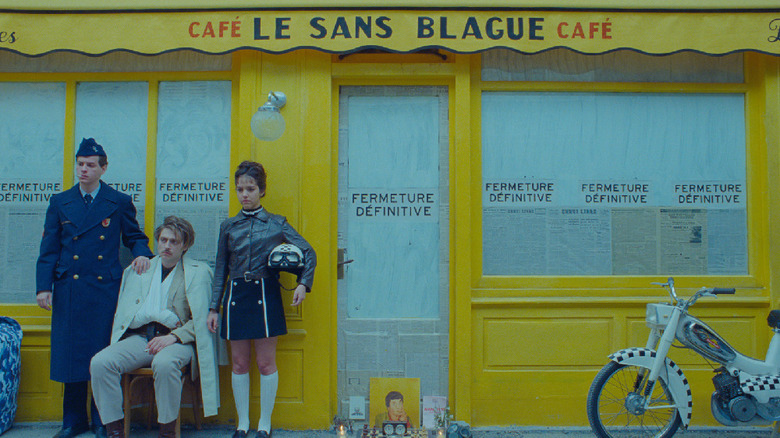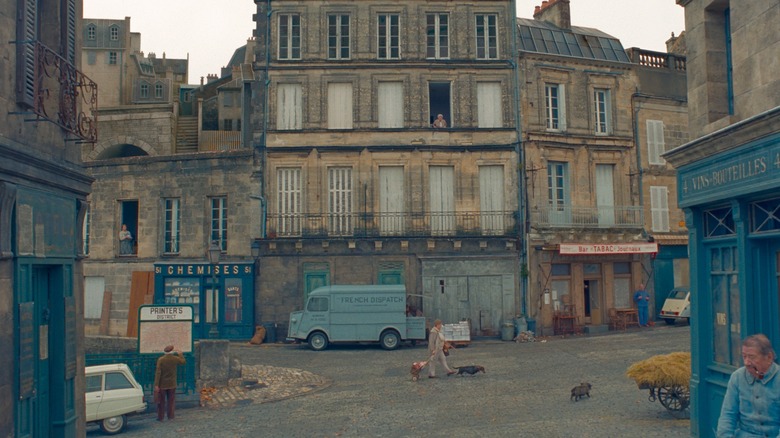The French Dispatch Set Decorator Rena DeAngelo Had A Wes Anderson-Like Adventure In France [Interview]
For the first time in her career, set decorator Rena DeAngelo has stepped into the world of Wes Anderson. DeAngelo, who previously earned an Oscar nomination for "Bridge of Spies," worked on around 150 sets for "The French Dispatch." Typically, eight of them would be going at once. Considering how visually dense the film is, that makes the number of sets all the more staggering.
DeAngelo half-jokes she's surprised they pulled it off. In addition to the large number of sets, they were created for three different stories — not to mention the framing device — which meant that each set had varying requirements and personalities. "The French Dispatch" is quite an epic that, clearly, DeAngelo had a ball helping to bring to life.
'This is going to be fun.'
One of the first steps of your job is talking to the production designer and director about the overall vision for the film. In this case, what was initially discussed?
The first conversations I had were with [production designer] Adam [Stockhausen]. Before I had a chance to read the script or anything, he showed me some location photos. He showed me some of the storyboards, so we got a little idea of what was going to happen. He'd said we were shooting in a small town in France. Basically, in 1950s post-war Paris, that is what he described it as. So that's pretty much what I went into it thinking I was embarking on.
And then when I got there and read the script on the plane on my way to Paris, I realized how much more it actually was. I couldn't even finish the script on the plane. I had to keep going back. Because, you saw the movie, there's so much involved. I didn't care, though. I just dove right in. I was like, "This is going to be fun."
It's a tall order.
Oh, yeah.
Where did you begin then?
I watched "The Grand Budapest Hotel” on the plane. I said, "I'll eat dinner, I'll watch 'Grand Budapest,' and then I'll start reading the script." And then I started reading the script and it was like, "There is no way I'm going to be able to finish this." I had to break it down. It took me three days to actually get through it and really have a concept of what we were doing.
At first, I wanted to get the lay of the land. We started prepping in Paris and I had great assistants who were taking me around. I had a general idea of what we were going for. We had Wes' storyboards and then we had the animated storyboard, then we had the photo reference library that Adam had amassed, so that gave us a good idea of what we wanted the film to look like.
Then I started shopping and seeing what I could come up with, which also helped steer what the sets were going to look like. Then we got to Angoulême and everything changed, because it was like, "Wow, look at this town." There were old abandoned warehouses and factories, and furniture makers. We were finding the coolest stuff in the world, which is what Wes loves. He wants you to really get into a location and find what you can find there, and that's what we did.
It was the greatest, I was in France, I was going to flea markets once a month, and just racing through and having my three French assistants follow after me.
That sounds like a Wes Anderson movie.
Oh my God, it should have been. They should have been making a movie of it, it was amazing. It was hilarious. Then the truck would go around and pick everything up. It was quite something.
'He has every frame of that movie already in his brain.'
What were some of the great finds in Angoulême?
Well, in the town of Angoulême itself, one of my assistants who was from the town, he knew of this guy who liquidated estates. He had this giant warehouse. It was just filled with amazing furniture and rugs and everything you could possibly want. Then we went to this, I don't even know what they made in this place. I think it was a book-binding, paper factory. We pulled the shelves out and put them in somebody's office. Oh, and then there was a guy who was an old pharmacy candy store that had been closed for about 35 years, and was just filled with stuff. Dirty stuff, but we cleaned it up and it was great.
You must get to meet a lot of characters.
Oh, yeah. You can't even imagine. The characters are all part of the job, and sometimes it's good and sometimes it's bad, but mostly it's good.
This was your first time working on a Wes Anderson film. What was unique about it?
Well, he has a singular vision of what he wants, every movie that he makes. When you start the movie, he has every frame of that movie already in his brain. He knows what it looks like and you're just trying to help him realize it. The process was talking to him every day and showing him what we were referencing, and trying to bring him what he wanted. He knows what he wants, and if you've ever tried to buy something for somebody and you're not in their head, that's what I was doing. I think I did it okay, I think I did well.
'Probably didn't notice that.'
What work went into creating The French Dispatch office?
We started off building that office at the beginning of the show. We were building it throughout, but we switched the schedule around so that we could actually dress each individual office by the end, after we got to know who each of the characters were. It helped to realize what each of the offices would look like, because we knew what the personality of each of these writers were.
Again, in the storyboard, it gave me a good idea of what he was thinking each of these rooms would look like. Very descriptive descriptions of what each of these writers' personalities were, so that helped me find the little elements that went into there, like the toast on a desk, that was scripted.
As you do with a movie, you just learn as you go. With Roebuck Wright's office, we kind of had an idea of what it looked like. Once we spent a few days with Jeffrey Wright and watched his character, Roebuck Wright, we wound up tweaking the wallpaper, we changed the color of the room. He wasn't the same guy as he was on the page once Jeffrey had started being Roebuck Wright. It completely changed what his office looked like.
How did the colors change? What did the office look like originally?
He was described to us as a combination of James Baldwin, maybe a little bit of Truman Capote thrown in there. So, his office was going to be a little bit more decorated than everybody else's. We had put this wallpaper up, which Adam and I kept looking at, and it kept looking like a funeral home to us. Then, we kept watching Jeffrey and I was like, "This is just so wrong." I found another wallpaper and at the last minute, they changed the wallpaper and then they made the beige wall pink. We never stopped running. It was constantly changing and ever evolving sets. We always had nine or 12 of them going at once.
Does that happen a lot where, once you see an actor playing a character it changes how you see a set?
Not so much. Sometimes, if you actually have the luxury of time to be able to really feel who the character is before we get into their home and their setting. It doesn't happen often, but sometimes it does. We were lucky that it happened on this one. I think we had a pretty good idea of who the characters were before they started their pieces, but it was nice to be able to have the time to really flesh them out the way we wanted to.
Sazerac's (Owen Wilson) office, he's only in the movie for a little bit, but that was fun. I was on a scavenger hunt of collecting amazing, vintage travel books and maps, and all the little tiny things. I had sand. I got a little crazy, I got a little carried away with his character. I had all the different rivers he'd been to and labeled them all. Probably didn't notice that, everything moved very quickly.
You probably need to see this movie a few times to take in all the detail.
Absolutely. You want to slow it down because the sets come at you rapid fire. I only saw it on the big screen once, a few weeks ago, and I had seen a screener of it last year before it almost came out. I still can't stop looking at all the stills in the pictures and just marveling at the fact that we actually pulled this thing off.
'This was a dream project to go into.'
How was it researching 1968 France?
There was so much photographic research of that time period in Paris. That was one of the most fun to do, I really liked that section of the film. I've been a little bit obsessed with Paris from the '50s and '60s for years and years. That's why this was a dream project to go into. Paris was beautiful, but it was beautiful in its seediness, and the buildings were a little bit crumbly. They were definitely worse for wear after the war.
After the war, you had these beautiful, amazing structures that were starting to get modernized. They weren't looking like the art deco beauties that they used to be. Now, a lot of formica was being brought in and a lot of glass, and a lot of mirrors, and a lot of '50s and '60s details that didn't quite fit with the architecture, but still really worked, and made the Paris cafes what they are today. So, that's why that section was fun.
Since the movie is a little heightened...
A little bit.
Could you use details from later time periods?
With Wes, you're never so specific to the date that you're dealing with. We were supposed to be in 1968 in the story with Fran and Timothée, but if there was stuff from the '70s that looked like they fit with what we were trying to do, that was okay, because it's not like we were making a documentary about 1968.
"The French Dispatch" is now in theaters.
